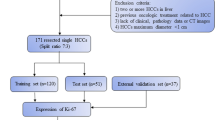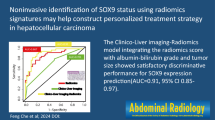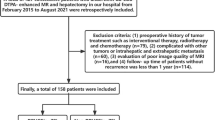Abstract
Objectives
The purpose of our project was to investigate the effectiveness of radiomic features based on contrast-enhanced computed tomography (CT) that can detect the expression of c-Met in hepatocellular carcinoma (HCC) and to validate its efficacy in predicting the outcome of sorafenib resistance.
Materials and Methods
In total, 130 patients (median age, 60 years) with pathologically confirmed HCC who underwent contrast material–enhanced CT from October 2012 to July 2020 were randomly divided into a training set (n = 91) and a test set (n = 39). Radiomic features were extracted from arterial phase (AP), portal venous phase (VP) and delayed phase (DP) images of every participant’s enhanced CT images.
Results
The entire group comprised 39 Met-positive and 91 Met-negative patients. The combined model, which included the clinical factors and the radiomic features, performed well in the training (area under the curve [AUC] = 0.878) and validation (AUC = 0.851) cohorts. The nomogram, which relied on the combined model, fits well in the calibration curves. Decision curve analysis (DCA) further confirmed that the clinical valuation of the nomogram achieved comparable accuracy in c-Met prediction. Among another 20 patients with HCC who had received sorafenib, the predicted high-risk group had shorter overall survival (OS) than the predicted low-risk group (p < 0.05).
Conclusion
A multivariate model acquired from three phases (AP, VP and DP) of enhanced CT, HBV-DNA and γ glutamyl transpeptidase isoenzyme II (GGT-II) could be considered a satisfactory preoperative marker of the expression of c-Met in patients with HCC. This approach may help in overcoming sorafenib resistance in advanced HCC.






Similar content being viewed by others
Abbreviations
- AFP:
-
a-Fetoprotein
- AP:
-
Arterial phase
- VP:
-
Portal venous phase
- DP:
-
Delayed phase
- AUC:
-
Area under curve
- CT:
-
Computed tomography
- DCA:
-
Decision curve analysis
- HCC:
-
Hepatocellular carcinoma
- ICC:
-
Intraclass correlation coefficients
- HGF:
-
Hepatocyte growth factor
- GGT-II:
-
γ glutamyl transpeptidase isoenzyme II
- VEGF:
-
Vascular endothelial growth factor
- MRI:
-
Magnetic resonance imaging
- TACE:
-
Transcatheter arterial chemoembolization
- DICOM:
-
Digital imaging and communications in medicine
- ROI:
-
Regions of interest
- Lasso:
-
Shrinkage and selection operator
- ROC:
-
Receiver operating characteristic curve
- CI:
-
Confidence interval
- OR:
-
Odds ratio
- OS:
-
Overall survival
- GLDM:
-
Grey level dependence matrix
- GLSZM:
-
Grey level size zone matrix
- GLRLM:
-
Grey level run length matrix
- GLCM:
-
Grey level co-occurrence matrix
References
Sung H, Ferlay J, Siegel RL et al (2021) Global Cancer Statistics 2020: GLOBOCAN estimates of incidence and mortality worldwide for 36 cancers in 185 countries. CA A Cancer J Clinicians 71:209–249. https://doi.org/10.3322/caac.21660
Villanueva A (2019) Hepatocellular carcinoma. N Engl J Med 380:1450–1462. https://doi.org/10.1056/NEJMra1713263
Llovet JM, Castet F, Heikenwalder M et al (2022) Immunotherapies for hepatocellular carcinoma. Nat Rev Clin Oncol 19:151–172. https://doi.org/10.1038/s41571-021-00573-2
Qin S, Bi F, Gu S et al (2021) Donafenib versus sorafenib in first-line treatment of unresectable or metastatic hepatocellular carcinoma: a randomized, open-label, parallel-controlled phase II-III trial. JCO 39:3002–3011. https://doi.org/10.1200/JCO.21.00163
Rebouissou S, Nault JC (2020) Advances in molecular classification and precision oncology in hepatocellular carcinoma. J Hepatol 72:215–229
Alqahtani A, Khan Z, Alloghbi A, Said Ahmed TS, Ashraf M, Hammouda DM (2019) Hepatocellular carcinoma: molecular mechanisms and targeted therapies. Medicina (Kaunas) 55(9):526. https://doi.org/10.3390/medicina55090526
Forner A, Reig M, Bruix J (2018) Hepatocellular carcinoma. Lancet 391:1301–1314
Firtina Karagonlar Z, Koc D, Iscan E, Erdal E, Atabey N (2016) Elevated hepatocyte growth factor expression as an autocrine c-Met activation mechanism in acquired resistance to sorafenib in hepatocellular carcinoma cells. Cancer Sci 107:407–416
Haibe Y, Kreidieh M, El Hajj H et al (2020) Resistance mechanisms to anti-angiogenic therapies in cancer. Front Oncol 10:221
Kuczynski EA, Yin M, Bar-Zion A et al (2016) Co-option of liver vessels and not sprouting angiogenesis drives acquired sorafenib resistance in hepatocellular carcinoma. J Natl Cancer Inst 108(8):djw030. https://doi.org/10.1093/jnci/djw030
Duplaquet L, Kherrouche Z, Baldacci S et al (2018) The multiple paths towards MET receptor addiction in cancer. Oncogene 37:3200–3215
Xiang QF, Zhan MX, Li Y et al (2019) Activation of MET promotes resistance to sorafenib in hepatocellular carcinoma cells via the AKT/ERK1/2-EGR1 pathway. Artif Cells Nanomed Biotechnol 47:83–89
Iwatate Y, Hoshino I, Yokota H et al (2020) Radiogenomics for predicting p53 status, PD-L1 expression, and prognosis with machine learning in pancreatic cancer. Br J Cancer 123:1253–1261
Ji GW, Zhu FP, Xu Q et al (2020) Radiomic features at contrast-enhanced CT predict recurrence in early stage hepatocellular carcinoma: a multi-institutional study. Radiology 294:568–579
Bouattour M, Raymond E, Qin S et al (2018) Recent developments of c-Met as a therapeutic target in hepatocellular carcinoma. Hepatology 67:1132–1149
Decaens T, Barone C, Assenat E et al (2021) Phase 1b/2 trial of tepotinib in sorafenib pretreated advanced hepatocellular carcinoma with MET overexpression. Br J Cancer 125:190–199
Bowen SR, Yuh WTC, Hippe DS et al (2018) Tumor radiomic heterogeneity: multiparametric functional imaging to characterize variability and predict response following cervical cancer radiation therapy. J Magn Reson Imaging 47:1388–1396
Lambin P, Leijenaar RTH, Deist TM et al (2017) Radiomics: the bridge between medical imaging and personalized medicine. Nat Rev Clin Oncol 14:749–762
Choi JY, Lee JM, Sirlin CB (2014) CT and MR imaging diagnosis and staging of hepatocellular carcinoma: part II. Extracellular agents, hepatobiliary agents, and ancillary imaging features. Radiology 273:30–50
Fan T, Li S, Li K et al (2022) A potential prognostic marker for recognizing VEGF-positive hepatocellular carcinoma based on magnetic resonance radiomics signature. Front Oncol 12:857715
Yuan G, Song Y, Li Q et al (2020) Development and validation of a contrast-enhanced CT-based radiomics nomogram for prediction of therapeutic efficacy of anti-PD-1 antibodies in advanced HCC patients. Front Immunol 11:613946
Packeisen J, Buerger H, Krech R, Boecker W (2002) Tissue microarrays: a new approach for quality control in immunohistochemistry. J Clin Pathol 55:613–615
van Griethuysen JJM, Fedorov A, Parmar C et al (2017) Computational radiomics system to decode the radiographic phenotype. Cancer Res 77:e104–e107
Aerts HJ, Velazquez ER, Leijenaar RT et al (2014) Decoding tumour phenotype by noninvasive imaging using a quantitative radiomics approach. Nat Commun 5:4006
Sun R, Limkin EJ, Vakalopoulou M et al (2018) A radiomics approach to assess tumour-infiltrating CD8 cells and response to anti-PD-1 or anti-PD-L1 immunotherapy: an imaging biomarker, retrospective multicohort study. Lancet Oncol 19:1180–1191
Zwanenburg A, Vallieres M, Abdalah MA et al (2020) The image biomarker standardization initiative: standardized quantitative radiomics for high-throughput image-based phenotyping. Radiology 295:328–338
Tibshirani R (1997) The lasso method for variable selection in the Cox model. Stat Med 16:385–395
Gu D, Xie Y, Wei J et al (2020) MRI-based radiomics signature: a potential biomarker for identifying glypican 3-positive hepatocellular carcinoma. J Magn Reson Imaging 52:1679–1687
Vickers AJ, Elkin EB (2006) Decision curve analysis: a novel method for evaluating prediction models. Med Decis Making 26:565–574
Segal E, Sirlin CB, Ooi C et al (2007) Decoding global gene expression programs in liver cancer by noninvasive imaging. Nat Biotechnol 25:675–680
Gillies RJ, Kinahan PE, Hricak H (2016) Radiomics: images are more than pictures, they are data. Radiology 278:563–577
Ng F, Kozarski R, Ganeshan B, Goh V (2013) Assessment of tumor heterogeneity by CT texture analysis: can the largest cross-sectional area be used as an alternative to whole tumor analysis? Eur J Radiol 82:342–348
Amini M, Nazari M, Shiri I et al (2021) Multi-level multi-modality (PET and CT) fusion radiomics: prognostic modeling for non-small cell lung carcinoma. Phys Med Biol 66(20). https://doi.org/10.1088/1361-6560/ac287d
Ozkan E, West A, Dedelow JA et al (2015) CT gray-level texture analysis as a quantitative imaging biomarker of epidermal growth factor receptor mutation status in adenocarcinoma of the lung. AJR Am J Roentgenol 205:1016–1025
Global Burden of Disease Liver Cancer C, Akinyemiju T, Abera S et al (2017) The burden of primary liver cancer and underlying etiologies from 1990 to 2015 at the global, regional, and national level: results from the Global Burden of Disease Study 2015. JAMA Oncol 3:1683–1691
Kazemi-Shirazi L, Endler G, Winkler S, Schickbauer T, Wagner O, Marsik C (2007) Gamma glutamyltransferase and long-term survival: is it just the liver? Clin Chem 53:940–946
Llovet JM, Pena CE, Lathia CD et al (2012) Plasma biomarkers as predictors of outcome in patients with advanced hepatocellular carcinoma. Clin Cancer Res 18:2290–2300
Hassan S, Ferrario C, Mamo A, Basik M (2008) Tissue microarrays: emerging standard for biomarker validation. Curr Opin Biotechnol 19:19–25
Acknowledgements
This study was supported by the Natural Science Foundation of China (82170514).
Author information
Authors and Affiliations
Corresponding authors
Ethics declarations
Conflict of Interest
The authors declare no competing interests.
Additional information
Publisher’s Note
Springer Nature remains neutral with regard to jurisdictional claims in published maps and institutional affiliations.
Rights and permissions
Springer Nature or its licensor (e.g. a society or other partner) holds exclusive rights to this article under a publishing agreement with the author(s) or other rightsholder(s); author self-archiving of the accepted manuscript version of this article is solely governed by the terms of such publishing agreement and applicable law.
About this article
Cite this article
Gu, J., Bao, S., Akemuhan, R. et al. Radiomics Based on Contrast-Enhanced CT for Recognizing c-Met-Positive Hepatocellular Carcinoma: a Noninvasive Approach to Predict the Outcome of Sorafenib Resistance. Mol Imaging Biol 25, 1073–1083 (2023). https://doi.org/10.1007/s11307-023-01870-1
Received:
Revised:
Accepted:
Published:
Issue Date:
DOI: https://doi.org/10.1007/s11307-023-01870-1




